|
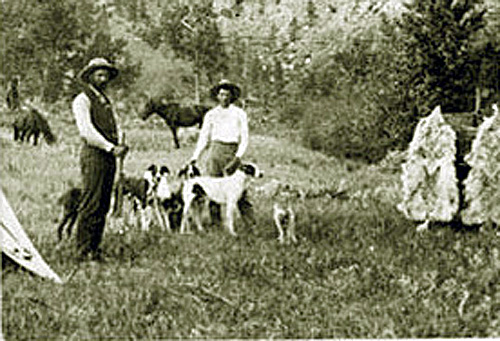
Wolfers, Crook County, undated
Wolves used to follow the great herds of bison that inhabited the plains. With the replacement of the bison with
cattle, ranchmen discovered their herds being ravaged by the gray wolf. Thus, trappers, known as "wolfers,"
would be employed by ranchmen to eliminate wolves who would attack
calves and sheep. Additionally, wolf skin collars were popular. Bounties for wolves and
coyotes were offered by the states. Montana, as an example, in 1895 offered a $3.00 bounty for wolves and coyotes.
In a six-month period some 3,000 wolves and 12,000 coyotes were killed. A good wolfer could earn as much
$3,000.00 a year. Indians, however, detested wolfers. Wolves were frequently killed
with poisoned bait. The Indian dogs would sometimes eat the bait. Indeed, Dakota ranchman,
Theodore Roosevelt commented:
"The only way to check in any degree the ravages of the
wolves is by the most liberal use of strychine and the offal of any game killed by
a cattle-man is pretty sure to be poisoned before being left while the
"wolfer," or professinal wolf killer strews his bait everywhere. It thus
comes about that any dog who is in the babit of going any
distance from the house is almost sure to run across and eat some
of the poisoned meat, the effect of which is certain death."
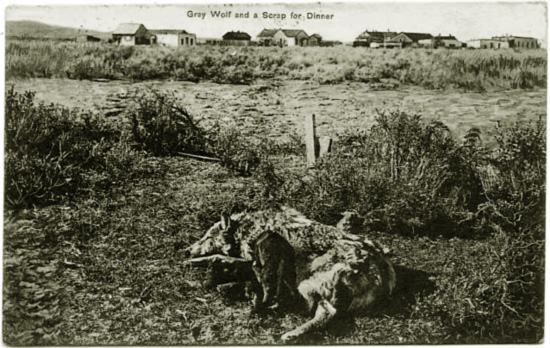
Wolf, Niobrara County, undated. Photo by H. R. Daniels.
The bait used by professional wolfers was not merely ofal. Typically it was a specidal concoction composed
of raw beef or venison left in a crock for a month or two until it thoroughly ripened. The
putrid meat was then mixed with extra ingredients such a skunk oil, beaver castor, and she-wolf urine. Each wolfer had
his own special blend.
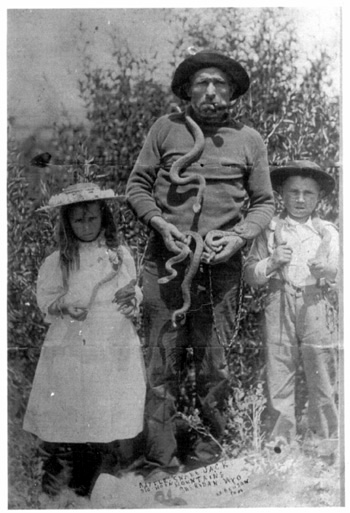
Rattlesnake Jack McIntyre with his children Martha and Albert, 1890's. Photo courtesy of Sheridan County
In Sheridan County, a wolfer of note was S. A. "Rattlesnake Jack" McIntyre, who hunted in the Bighorns and from Ucross north
to Montana in the late
1880's and early 1890's. In 1895, Rattlesnake Jack moved to northern Nebraska. Jack, who also for a time, ran
a traveling snake show, moved to Buffalo after Nebraska authorities took his daughter Martha away from him as a
result of his allowing her to play with his pet rattlesnakes. The authorities also attempted to take away his
son Albert on the charges against the boy of "vagrancy and mendicancy." A mendicant is a beggar. Jack was allowed to
keep custody of Albert only on the promise that he would not longer allow the boy to play with the
snakes. Rattlesnake Jack often carried the snakes with him
under his shirt. In Gillette, he created a stir when he released the
snakes in a local saloon.
Throughout the west, it appears,
the name "Rattlesnake Jack" was a popular nickname. One of the richer gold mines discovered in the
Blackhills was the Rattlesnake Jack mine discovered by a California prospector of that name.
In 1882, an outlaw by that name was killed in Weiser City, Idaho. In 1885, a cowboy using that name was convicted of rustling. and
sent off to Joliet for 2 1/2 years. Another wolfer in western Colorado bore the same moniker as did a lady
homesteader in South Dakota.
Rattlesnake Jack McIntyre was not immune from being bitten by rattlesnakes. The Omaha Bee, July 26, 1896, reported that Jack,
a "repulsive character," had been bitten. According to the account, the United States marshal reported that the
"snake is in a bad way." Another paper referred to him as "a dirty, loathsome, opium fiend."
The reason that he might have been regarded as loathsome or repulsive was that he did not believe in soap. He
regarded it as being easily smelled by the wolves. Addtionally, the aroma of his bait tended to impart itself
to all of his personal effects including his clothing. The result was that ranchmen wishing to employ
his services, would do the negotiation outside where, hopefully, fresh winds would dissippate the
aroma.
By 1898, Jack was working as a wolfer on the Tisdale Ranch in Johnson County. In one year, working for Tisdale, he
killed 98 wolves and 500 ooyotes. In the late 1890's, ranchmen in the North Park area and in the
southern Medicine Bows had a major problem with wolves killing cattle and horses. Thus in 1901, the
the Upper Big Laramie Live Stock Protective Association employed Rattlesnake Jack offering a bounty of $20.00 for each wolf. By 1902, the
bounty had increased to $96.00 for a grown wolf and $23.00 for young ones. By 1911, Rattlesnake
Jack was employed by the federal government as a wolfer for $75.00 a month. On March 8, 1911, the
Daily Boomerang reported (grammer and spelling as in the original):
Walden, Col. Mar 8,--S.A. McIntyre, better known in this region as "Rattlesnake Jack" in the agonies of
cramps, of which he was subjected to, to end his misery blowed his brains out with a shot gun
Saturday evening at his cabin over near the Hardy ranch.
He had been sick all days and Albert, is son, coming home in the evening found his father in
great pain, and so fixed him up some Jamaica ginger, which he though would relieve him for a while, and then went out to
the stable to get his horse ready to go after aid. While Albert was saddling his horse he heard a shot fired
and upon going to the house saw his father lying on the cot, and blood spattered over everything. The shot tore his
head from above the mouth clear off. Death was instaneous.
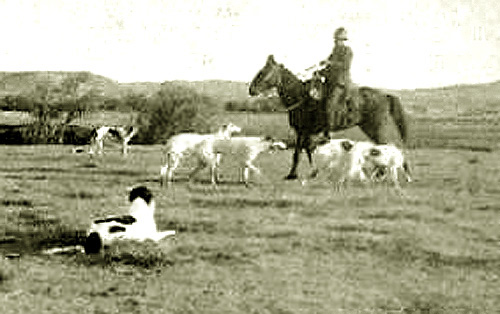
Wyoming Wolfer, 1904.
In Sheridan County, the feeling of repulsion at Jack apparently continued. The
Sheridan Post reported:
For a decade prior to 1900, Rattlesnake Jack made his headquarters at Sheridan, while he trapped and hunted over
the adjacent country. He was known to practically every person in Sheridan and
Johnson counties, and there is none who will regret his taking off. When his old acquaintances heard of the
suicide, one and all made the same comment: "It's too bad it did not happen earlier--that is about the
only commendable thing old Jack ever did."
At the time of his death, Jack had fairly well solved the wolf problem along the Upper Big Laramie and the government
was going to transfer him elsewhere. By 1915, the wolves had returned. In july, 1915, the
government brought in Albert. Albert killed the wolf primarily blamed, one called "Two Toes."
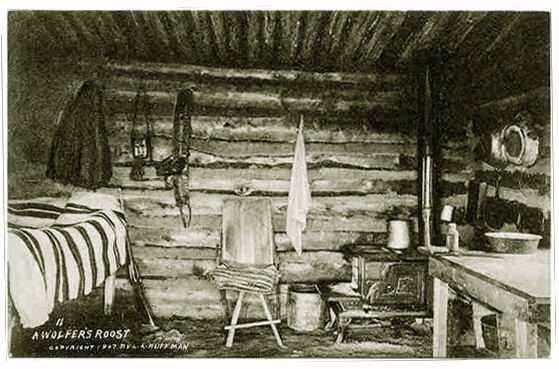
Interior of a Wolfer's cabin. Photo by Laton Alton Huffman, 1907.
In 1943, at Muddy Creek along the southern base of the Owl Creek Mountains, the last Wyoming wolf prior to the recent reintroductions was killed.
The animal was mistaken for a coyote that had been killing sheep. The sheepherder declined
the $5.00 bounty.
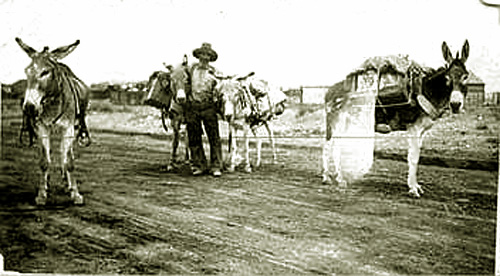
Daniel Latham, an Iron Mountain trapper, undated, photo courtesy Margie McDonald Schrey
Even today, trapping of
predatory animals is a viable profession. In Wyoming, predatory animal districts are authorized to
pay bounties. Funding is provided by a fee payable as a part of the brand
inspection program and from the sale of pelts. There is the story of the new
clerk in Albany County who was rumaging about the vault and came across a cardboard
carton and inquired as to what it contained. Its contents were old mummified
coyote ears upon which bounties had been paid.
Next page: brands.
|